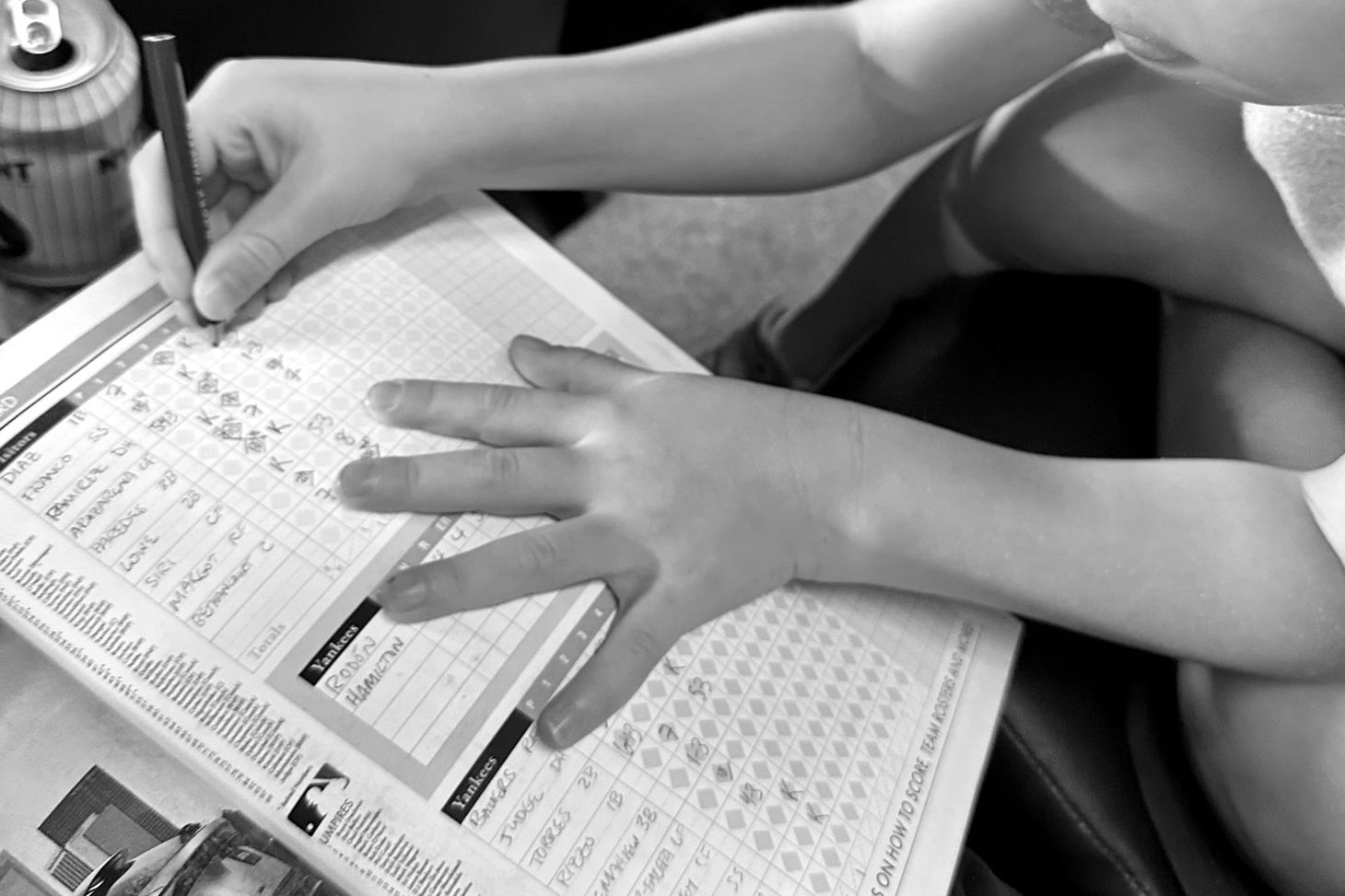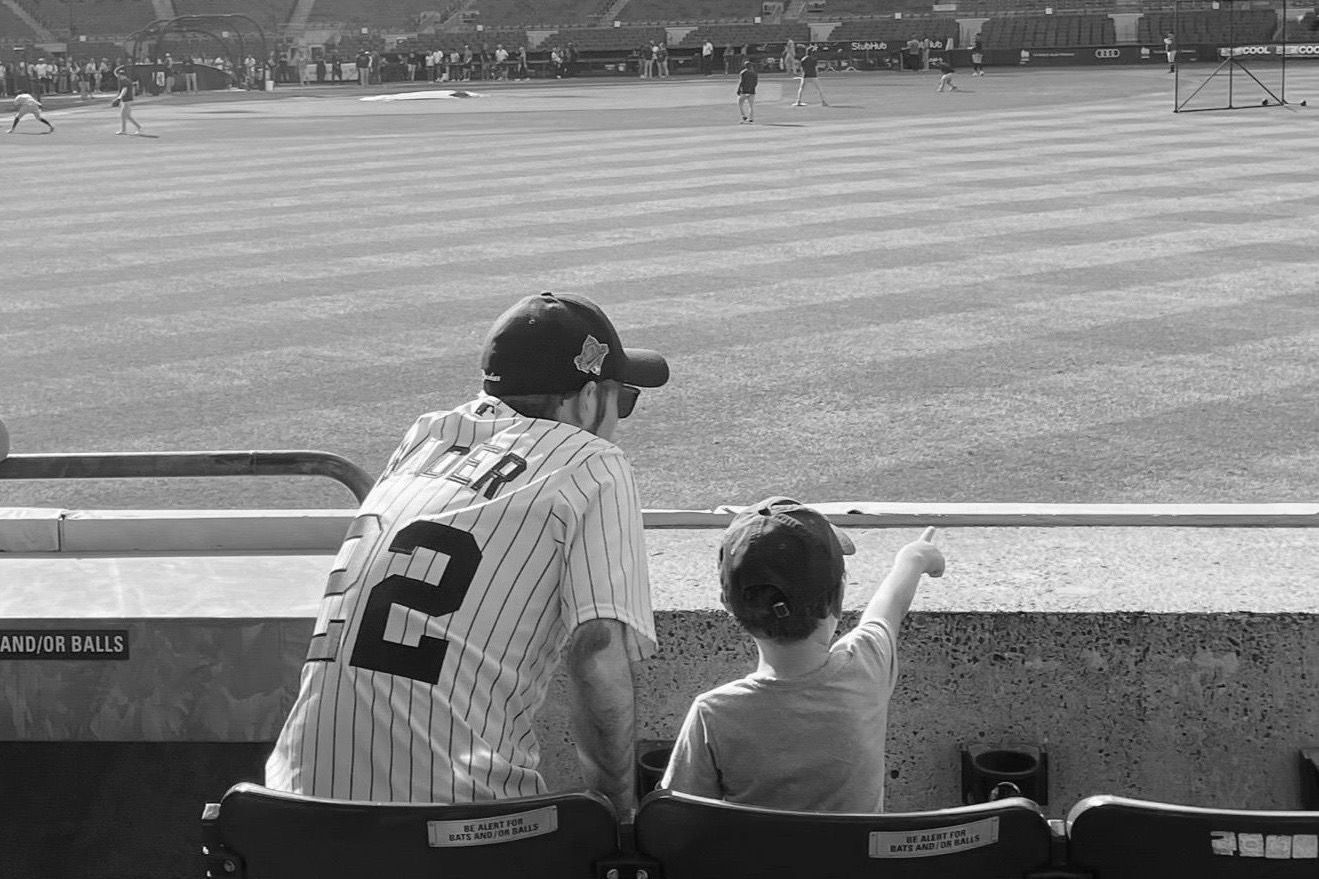Keeping score
With a stubby blue pencil, no eraser.

I took my 6-year-old to Yankee Stadium last week. It was his second visit, but the first since he really started to show an interest in baseball. He got the full experience: a tour of Monument Park, a ball from batting practice, a giant foam finger—everything but a Yankees victory, which have been elusive this season.
Walking around before the game started, I surprised myself by purchasing a program with a scorecard inserted in the middle. Two decades had passed since I last kept score at a game. The programs cost $10 now, and you can't even pay with cash, but they still come with the same stubby blue pencil with no eraser.
Keeping score was out-of-fashion even when I was a kid. Some scorecard notation—K's for strikeouts, say, or a 6-4-3 double play—has survived thanks to announcers who keep score in the broadcast booth. Otherwise, it's a relic. There's never any line at the vendor selling yearbooks and programs.
Yet there's no shortage of baseball fans who, if handed a scorecard today, could instantly recall the cuneiform and start scratching each play into the grid. I was taught by my dad, who was taught by his dad, and everyone who knows how to keep score has a similar story. Like dropped third strikes and the infield-fly rule, keeping score is easy to grasp, but someone still needs to explain it in the first place. Passing down the knowledge creates a legacy.

Baseball is so thick with nostalgia you can't help but think about the memory of a game even while it's happening. "Longing on a large scale is what makes history," Don DeLillo wrote in his novella about Bobby Thomson's home run. When you go to the stadium with your son, his mom, and his grandmother, it's religious. But unlike the kind of nostalgia that revels in what no longer is or will be (there's plenty of that in baseball, too), keeping score is an act of keeping the moment alive.
Of course I bought a scorecard. My son doesn't yet know all the fundamentals of baseball, let alone how to read, so we'll have to come back next season to bequeath the details. I mostly scored this game myself, with his assistance.
What I had forgotten is how much more present you feel when keeping score. Obviously you have to follow each play in order to write it down in the scorecard, but I mean more than just paying attention to the game. You become attentive to details well beyond the play-by-play: the game's pace and feel, opportunities that presented themselves and were lost, patterns repeating themselves across the grid. Details around the stadium are more vivid, too: how the crowd fills in after the first inning, the beer hawker's path through the stands, and so on.
Like journaling, taking notes, and other acts of written observation, keeping score places you in the moment now and forever. You are part of the game and its history, keeper of an informal record that this happened and you were there. As a journalist, naturally, the idea of record-keeping as bearing-witness appeals to me, but I think anyone can appreciate the power of memorializing an event as it occurs. Your notes—in pencil, no eraser—give the event a kind of immortality.
Oral histories, folklore, and scriptures have this strength, too. Their retelling keeps the story alive (and much more powerfully, I should be clear, than a scorecard, which, if it's lucky, is stashed in a drawer after the game and pulled out from time to time). A written or verbal account is about being there, forever. At least that's how it felt filling out my scorecard at the stadium last week.

If keeping score is outdated, the new fashion is of course to snap photos at the game, and of course we did plenty of that, too. It's trite to say that pulling out your phone takes you out of the moment. I don't think that's true. But pictures from the stands certainly have a different effect than writing down what you see.
Susan Sontag and Roland Barthes both famously observed that photography is a kind of death. "Photography is the inventory of mortality," Sontag wrote in her famous essays for the New York Review of Books. "Its testimony bears not on the object, but on time," Barthes wrote in Camera Lucida, a short book I read in college and have kept close to me ever since. They argued that photographs, in capturing a scene that's instantly in the past, can only be viewed from our present perspective, emphasizing the chasm between now (us) and then (them).
I was eight-years-old when I saw Jim Abbott pitch a no-hitter at Yankee Stadium. I have two keepsakes from the game: a framed, glossy photo of me, my dad, and our family friends celebrating in the crowd afterward; and my scorecard.
When I see the photo, I think about how much time has passed—30 years next month—and how different we all look now. I can see the sheer excitement of the moment and even catch a glimpse of what it felt like to share in one of baseball's greatest feats, made all the more incredible because Abbott did it with only one hand. I can hear a distant roar from the astonished crowd. But it's all a faint memory, receding further into the past the more I stare at the photo.
My scorecard tells a different story. The Cleveland Indians put up a formidable lineup that day, including Albert Belle, Manny Ramirez, and Kenny Lofton, who attempted a bunt in his last at-bat that nearly spoiled the no-no (B 4-3). The Yankees were lucky to grab an early lead, when successive throwing errors on the same play (E8 and E5) allowed two runs to score. Abbott himself was hardly perfect: He only had three K's, gave up five BB's, and had to pitch himself out of trouble in the fifth, inducing Ramirez into a rally-killing double play (6-4-3). A deep fly ball to center in the ninth had the entire ballpark holding its breath before Bernie Williams tracked it down in front of the Yankees' bullpen (8!).
It's a memory, too, but a far more vivid one. Along the top of the scorecard, I took note of the attendance (27,125, not packed for a weekend day game), and the curled paper edges recall that it drizzled throughout the game. The only explicit reference to a no-hitter is Abbott's pitching line (9 IP, 0 H, 0 R, 0 ER, 5 BB, 3 K). Every graphite marking brings the story alive as strongly today as in 1993.
After scoring the game last week, I wrote the date across the top and added, "Hugo's first night game." The game itself was unremarkable, with the Yankees losing, 5-2, on weak hitting, but a few crooked notations on the scorecard suggest a child's hand at work. When we got home, I put the program in a drawer.
Read more from Zach
Sign up to receive occasional emails with new posts.

